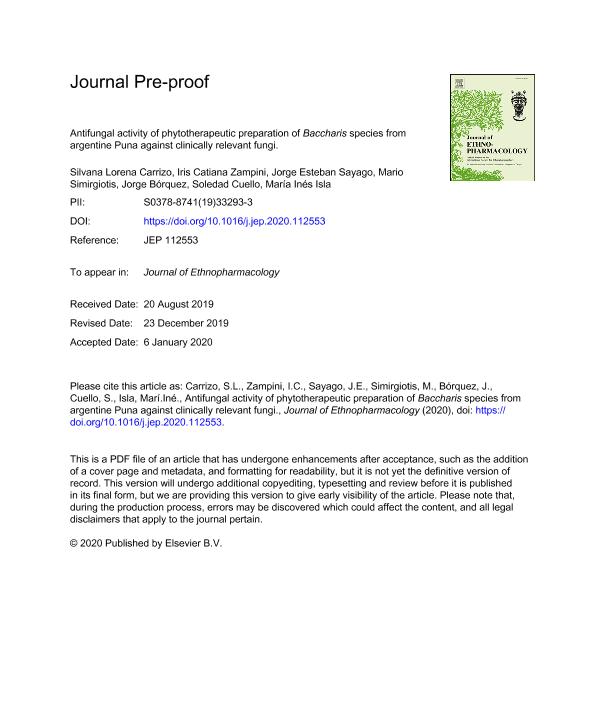Mostrar el registro sencillo del ítem
dc.contributor.author
Carrizo, Silvana Lorena

dc.contributor.author
Zampini, Iris Catiana

dc.contributor.author
Sayago, Jorge Esteban

dc.contributor.author
Simirgiotis, Mario Juan

dc.contributor.author
Bórquez, Jorge
dc.contributor.author
Cuello, Ana Soledad

dc.contributor.author
Isla, Maria Ines

dc.date.available
2021-09-01T02:59:45Z
dc.date.issued
2020-04-08
dc.identifier.citation
Carrizo, Silvana Lorena; Zampini, Iris Catiana; Sayago, Jorge Esteban; Simirgiotis, Mario Juan; Bórquez, Jorge; et al.; Antifungal activity of phytotherapeutic preparation of Baccharis species from argentine Puna against clinically relevant fungi; Elsevier Ireland; Journal of Ethnopharmacology; 251; 8-4-2020; 1-40; 112553
dc.identifier.issn
0378-8741
dc.identifier.uri
http://hdl.handle.net/11336/139392
dc.description.abstract
Ethnopharmacological relevance: B. boliviensis and B. tola are used in traditional medicine in the Argentine Puna to treat skin and soft tissue infections and inflammatory processes in humans and animals. Aim of the study: To assess the potential of phytotherapeutic preparations of Baccharis species as antifungal agents against clinically relevant fungi and to determine the chemical composition of the extracts. Material and methods: Phytotherapeutic preparations of B. boliviensis and B. tola collected in Argentine Puna were evaluated as an antifungal agent against clinically relevant fungi (yeast, non-dermatophytes, and dermatophytes) isolated of patients from a local Hospital, and reference strains, using macrodilution and microdilution assays. The bioactivity was supported by UHPLC-OT-MS metabolome fingerprinting. Results: The results revealed that the plant preparations were active against most of evaluated fungal strains; B. boliviensis was more active than B. tola. Dermatophyte fungi strains were the most sensitive isolates. The phytotherapeutic preparation showed Minimal Inhibitory Concentration (MIC) values between 25 and 400 μg GAE/mL and Minimum Fungicidal Concentration (MFC) values between 50 and 400 μg GAE/mL. Regarding the phytochemical analysis, total phenolic and total flavonoid contents of hydroalcoholic preparation of B. boliviensis were greater than those of the B. tola extract. Both Baccharis species showed similar chromatographic patterns, fifty-two compounds were identified based on UHPLC-OT-MS including several terpenoids, flavonoids and phenolic acids that have been identified in this two endemic South American Baccharis species for the first time. Several identified compounds present antifungal properties, the presence of these compounds support the bioactivity of the Baccharis extracts. Conclusions: In this work the traditional use of both Baccharis species as an antimicrobial against commercial products resistant fungal strains was validate, principally against dermatophytes fungi such as T. rubrum, T. mentagrophytes, M. canis, and M. gypseum. These results indicate that the hydroalcoholic preparations could be used for the treatment of fungal infectious.
dc.format
application/pdf
dc.language.iso
eng
dc.publisher
Elsevier Ireland

dc.rights
info:eu-repo/semantics/openAccess
dc.rights.uri
https://creativecommons.org/licenses/by-nc-nd/2.5/ar/
dc.subject
ANTIFUNGAL ACTIVITY
dc.subject
ARGENTINE PUNA
dc.subject
BACCHARIS BOLIVIENSIS
dc.subject
BACCHARIS TOLA
dc.subject
DERMATOPHYTES
dc.subject.classification
Otras Ciencias Biológicas

dc.subject.classification
Ciencias Biológicas

dc.subject.classification
CIENCIAS NATURALES Y EXACTAS

dc.title
Antifungal activity of phytotherapeutic preparation of Baccharis species from argentine Puna against clinically relevant fungi
dc.type
info:eu-repo/semantics/article
dc.type
info:ar-repo/semantics/artículo
dc.type
info:eu-repo/semantics/publishedVersion
dc.date.updated
2021-04-28T21:08:40Z
dc.journal.volume
251
dc.journal.pagination
1-40; 112553
dc.journal.pais
Irlanda

dc.journal.ciudad
Shannon
dc.description.fil
Fil: Carrizo, Silvana Lorena. Universidad Nacional de Tucumán. Instituto de Bioprospección y Fisiología Vegetal. Consejo Nacional de Investigaciones Científicas y Técnicas. Centro Científico Tecnológico Conicet Noa Sur. Instituto de Bioprospección y Fisiología Vegetal; Argentina
dc.description.fil
Fil: Zampini, Iris Catiana. Universidad Nacional de Tucumán. Instituto de Bioprospección y Fisiología Vegetal. Consejo Nacional de Investigaciones Científicas y Técnicas. Centro Científico Tecnológico Conicet Noa Sur. Instituto de Bioprospección y Fisiología Vegetal; Argentina. Universidad Nacional de Tucumán. Facultad de Ciencias Naturales e Instituto Miguel Lillo; Argentina
dc.description.fil
Fil: Sayago, Jorge Esteban. Universidad Nacional de Tucumán. Instituto de Bioprospección y Fisiología Vegetal. Consejo Nacional de Investigaciones Científicas y Técnicas. Centro Científico Tecnológico Conicet Noa Sur. Instituto de Bioprospección y Fisiología Vegetal; Argentina. Universidad Nacional de Tucumán. Facultad de Bioquímica, Química y Farmacia; Argentina. Universidad Nacional de Tucumán. Facultad de Ciencias Naturales e Instituto Miguel Lillo; Argentina
dc.description.fil
Fil: Simirgiotis, Mario Juan. Consejo Nacional de Investigaciones Científicas y Técnicas; Argentina. Universidad Austral de Chile; Chile
dc.description.fil
Fil: Bórquez, Jorge. Universidad de Antofagasta. Facultad de Ciencias Básica. Departamento de Química. Laboratorio de Productos Naturales; Chile
dc.description.fil
Fil: Cuello, Ana Soledad. Universidad Nacional de Tucumán. Instituto de Bioprospección y Fisiología Vegetal. Consejo Nacional de Investigaciones Científicas y Técnicas. Centro Científico Tecnológico Conicet Noa Sur. Instituto de Bioprospección y Fisiología Vegetal; Argentina. Universidad Nacional de Tucumán. Facultad de Ciencias Naturales e Instituto Miguel Lillo; Argentina
dc.description.fil
Fil: Isla, Maria Ines. Universidad Nacional de Tucumán. Instituto de Bioprospección y Fisiología Vegetal. Consejo Nacional de Investigaciones Científicas y Técnicas. Centro Científico Tecnológico Conicet Noa Sur. Instituto de Bioprospección y Fisiología Vegetal; Argentina. Universidad Nacional de Tucumán. Facultad de Ciencias Naturales e Instituto Miguel Lillo; Argentina
dc.journal.title
Journal of Ethnopharmacology

dc.relation.alternativeid
info:eu-repo/semantics/altIdentifier/url/https://www.sciencedirect.com/science/article/abs/pii/S0378874119332933
dc.relation.alternativeid
info:eu-repo/semantics/altIdentifier/doi/https://doi.org/10.1016/j.jep.2020.112553
Archivos asociados
